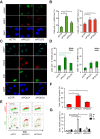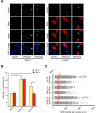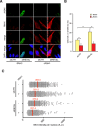Roles of human POLD1 and POLD3 in genome stability
- PMID: 27974823
- PMCID: PMC5156928
- DOI: 10.1038/srep38873
Roles of human POLD1 and POLD3 in genome stability
Abstract
DNA replication is essential for cellular proliferation. If improperly controlled it can constitute a major source of genome instability, frequently associated with cancer and aging. POLD1 is the catalytic subunit and POLD3 is an accessory subunit of the replicative Pol δ polymerase, which also functions in DNA repair, as well as the translesion synthesis polymerase Pol ζ, whose catalytic subunit is REV3L. In cells depleted of POLD1 or POLD3 we found a differential but general increase in genome instability as manifested by DNA breaks, S-phase progression impairment and chromosome abnormalities. Importantly, we showed that both proteins are needed to maintain the proper amount of active replication origins and that POLD3-depletion causes anaphase bridges accumulation. In addition, POLD3-associated DNA damage showed to be dependent on RNA-DNA hybrids pointing toward an additional and specific role of this subunit in genome stability. Interestingly, a similar increase in RNA-DNA hybrids-dependent genome instability was observed in REV3L-depleted cells. Our findings demonstrate a key role of POLD1 and POLD3 in genome stability and S-phase progression revealing RNA-DNA hybrids-dependent effects for POLD3 that might be partly due to its Pol ζ interaction.
Figures






Similar articles
-
Human POLD1 modulates cell cycle progression and DNA damage repair.BMC Biochem. 2015 Jun 19;16:14. doi: 10.1186/s12858-015-0044-7. BMC Biochem. 2015. PMID: 26087769 Free PMC article.
-
The POLD3 subunit of DNA polymerase δ can promote translesion synthesis independently of DNA polymerase ζ.Nucleic Acids Res. 2015 Feb 18;43(3):1671-83. doi: 10.1093/nar/gkv023. Epub 2015 Jan 27. Nucleic Acids Res. 2015. PMID: 25628356 Free PMC article.
-
POLD1: Central mediator of DNA replication and repair, and implication in cancer and other pathologies.Gene. 2016 Sep 15;590(1):128-41. doi: 10.1016/j.gene.2016.06.031. Epub 2016 Jun 16. Gene. 2016. PMID: 27320729 Free PMC article. Review.
-
Pold3 is required for genomic stability and telomere integrity in embryonic stem cells and meiosis.Nucleic Acids Res. 2018 Apr 20;46(7):3468-3486. doi: 10.1093/nar/gky098. Nucleic Acids Res. 2018. PMID: 29447390 Free PMC article.
-
POLD3 as Controller of Replicative DNA Repair.Int J Mol Sci. 2024 Nov 19;25(22):12417. doi: 10.3390/ijms252212417. Int J Mol Sci. 2024. PMID: 39596481 Free PMC article. Review.
Cited by
-
Human RTEL1 associates with Poldip3 to facilitate responses to replication stress and R-loop resolution.Genes Dev. 2020 Aug 1;34(15-16):1065-1074. doi: 10.1101/gad.330050.119. Epub 2020 Jun 19. Genes Dev. 2020. PMID: 32561545 Free PMC article.
-
Inactivating Mutations in Exonuclease and Polymerase Domains in DNA Polymerase Delta Alter Sensitivities to Inhibitors of dNTP Synthesis.DNA Cell Biol. 2020 Jan;39(1):50-56. doi: 10.1089/dna.2019.5125. Epub 2019 Nov 21. DNA Cell Biol. 2020. PMID: 31750734 Free PMC article.
-
Promoter methylation of DNA damage repair (DDR) genes in human tumor entities: RBBP8/CtIP is almost exclusively methylated in bladder cancer.Clin Epigenetics. 2018 Feb 6;10:15. doi: 10.1186/s13148-018-0447-6. eCollection 2018. Clin Epigenetics. 2018. PMID: 29445424 Free PMC article.
-
Alternative lengthening of telomeres: mechanism and the pathogenesis of cancer.J Clin Pathol. 2024 Jan 18;77(2):82-86. doi: 10.1136/jcp-2023-209005. J Clin Pathol. 2024. PMID: 37890990 Free PMC article.
-
Elevated DNA Polymerase Delta 1 Expression Correlates With Tumor Progression and Immunosuppressive Tumor Microenvironment in Hepatocellular Carcinoma.Front Oncol. 2021 Nov 11;11:736363. doi: 10.3389/fonc.2021.736363. eCollection 2021. Front Oncol. 2021. PMID: 34868924 Free PMC article.
References
-
- Hubscher U., Maga G. & Spadari S. Eukaryotic DNA polymerases. Annu Rev Biochem 71, 133–163 (2002). - PubMed
Publication types
MeSH terms
Substances
LinkOut - more resources
Full Text Sources
Other Literature Sources
Miscellaneous

